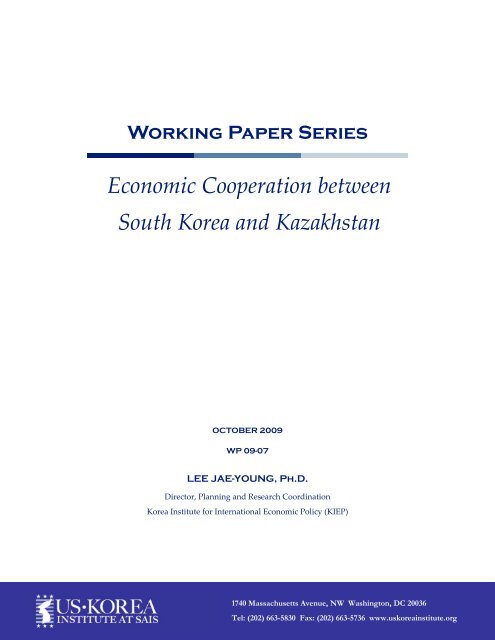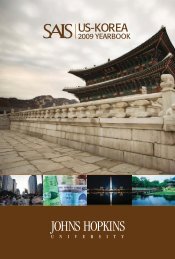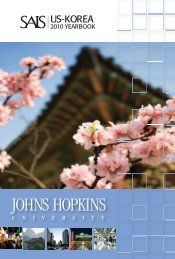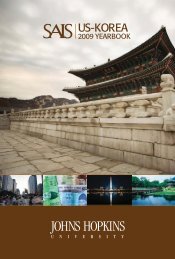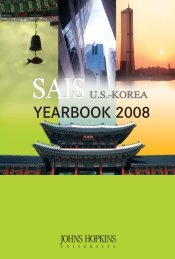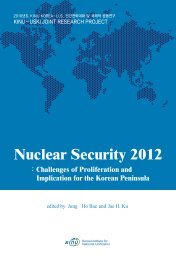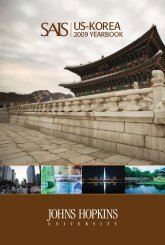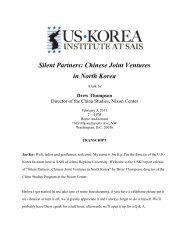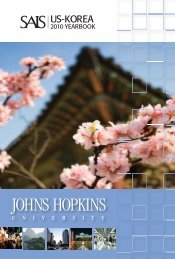Economic Cooperation between South Korea and Kazakhstan
Economic Cooperation between South Korea and Kazakhstan
Economic Cooperation between South Korea and Kazakhstan
Create successful ePaper yourself
Turn your PDF publications into a flip-book with our unique Google optimized e-Paper software.
Working Paper Series<strong>Economic</strong> <strong>Cooperation</strong> <strong>between</strong><strong>South</strong> <strong>Korea</strong> <strong>and</strong> <strong>Kazakhstan</strong>OCTOBER 2009WP 09-07LEE JAE-YOUNG, Ph.D.Director, Planning <strong>and</strong> Research Coordination<strong>Korea</strong> Institute for International <strong>Economic</strong> Policy (KIEP)1740 Massachusetts Avenue, NW Washington, DC 20036Tel: (202) 663-5830 Fax: (202) 663-5736 www.uskoreainstitute.org
Lee Jae-young is the Director of Planning <strong>and</strong> Research Coordination at the <strong>Korea</strong> Institute for International <strong>Economic</strong> Policy (KIEP). He is also anAdvisory Council Member for the National Intelligence Service of <strong>Korea</strong>. He has served as an Advisory Council Member for the <strong>Korea</strong>n Railroad Corporation<strong>and</strong> the Head of the Research Division for the International High Speed Rail <strong>Cooperation</strong> Forum.Dr. Lee holds a B.A. in <strong>Economic</strong>s <strong>and</strong> an M.B.A. from Hanyang University, <strong>and</strong> a Ph.D. in <strong>Economic</strong>s from Moscow State University. He has taught atthe Asia-Pacific Research Center at Hanyang University <strong>and</strong> has served as a Visiting Scholar/Research Fellow at several academic institutions including:the Davis Center for Russian <strong>and</strong> Eurasian Studies at Harvard University, the Asia-Pacific Research Center <strong>and</strong> the Institute for Sino-Soviet Studies atHanyang University, <strong>and</strong> the Institute of Far Eastern Studies at the Academy of Sciences of the USSR. Dr. Lee is widely published on East Asian <strong>and</strong><strong>Korea</strong>n economic relations with Russia <strong>and</strong> Central Asia.Note: This paper was prepared exclusively for the U.S.-<strong>Korea</strong> Institute’s Working Paper Series.The U.S.-<strong>Korea</strong> Institute at SAIS (USKI) is part of an extensive program which began in 2006 to make SAIS a hub of <strong>Korea</strong>-related activities in theWashington, D.C. area. USKI’s mission is to increase information <strong>and</strong> underst<strong>and</strong>ing of <strong>Korea</strong> <strong>and</strong> <strong>Korea</strong>n affairs in the United States through innovativeresearch, educational <strong>and</strong> policy forums, <strong>and</strong> interaction with leading U.S. <strong>and</strong> <strong>Korea</strong>n policymakers. USKI is generously funded by the <strong>Korea</strong> Institutefor International <strong>Economic</strong> Policy, the <strong>Korea</strong> Foundation, <strong>and</strong> private <strong>Korea</strong>n <strong>and</strong> American donors. To find out more about USKI, visitwww.uskoreainstitute.org.Copyright © 2008 by the U.S.-<strong>Korea</strong> Institute at SAIS. All rights reserved. No part of this working paper may be reproduced or utilized in any form or by any means, electronicor mechanical, including photocopying, recording, or by information storage or retrieval system, without permission from the Institute.
U.S.‐<strong>Korea</strong> Institute Working Paper Series<strong>Economic</strong> <strong>Cooperation</strong> <strong>between</strong> <strong>South</strong> <strong>Korea</strong> <strong>and</strong> <strong>Kazakhstan</strong>ECONOMIC COOPERATION BETWEEN SOUTH KOREA AND KAZAKHSTANCentral Asia is composed of five countries, <strong>Kazakhstan</strong>, Kyrgyzstan, Tajikistan, Turkmenistan, <strong>and</strong> Uzbekistan. It covers anarea of 3,916,000 square kilometers with a total population of 56.92 million <strong>and</strong> possesses abundant underground resources<strong>and</strong> extensive farml<strong>and</strong> areas. 1 Once known as the center of Silk Road, Central Asia used to play a minor role in the internationaleconomy during the Soviet era. However, since the dissolution of the Soviet Union, Central Asia’s role has been risingto the surface, being watched by the world with keen interest. The abrupt change of the strategic environment for CentralAsia is the main reason behind the region’s increasingly important role. In this way, we could not agree more with Sodiq Safaev’scomment: “Central Asia has been reclaiming its geopolitical <strong>and</strong> geoeconomic role, which used to be played by the areafrom 8 BC to the latter half of the Middle Ages.” 2 Now, Central Asia is no longer in the outskirts of the international communityfor it has become strategically important in determining the geopolitical relationship of the Eurasian Continent, <strong>and</strong>has gained strategic interests from major countries of the world.The first reason for Central Asia’s increasing geopolitical <strong>and</strong> geoeconomic role is based on the region’s location. CentralAsia is located in the Eurasian Continent <strong>between</strong> Asia <strong>and</strong> Europe, <strong>and</strong> holds great strategic importance in terms of military<strong>and</strong> security. Second, this area has large amounts of oil <strong>and</strong> gas resources, enough to be called “the second Middle East,” <strong>and</strong>therefore, the region is economically valuable as a new source of supply for energy resources. Third, Central Asia is rising as aprospective market for promising products <strong>and</strong> being viewed as a region for good investment because the region has beenexp<strong>and</strong>ing the infrastructure of its main industries into a structure centered on energy exports. Fourth, since Central Asiaserves as an intersecting point that connects the Eurasian continent in all directions, it is likely to become one of the maininternational distribution centers. Finally, among Brazil, Russia, India, <strong>and</strong> China (BRICs), Central Asia is adjacent to all ofthem except for Brazil, which demonstrates its potential for future development <strong>and</strong> its important role of forming an economiccommunity for the Eurasian continent in the long run.Recently, as the strategic value of Central Asia has been growing, major world players have been advancing into Central Asia.Russia, China, India, <strong>and</strong> Japan are all strengthening their relationships with the countries in Central Asia <strong>and</strong> also competingagainst each other to increase energy <strong>and</strong> economic cooperation with the countries in Central Asia. Central Asia is importantboth politically <strong>and</strong> economically from <strong>South</strong> <strong>Korea</strong>’s point of view. First, for <strong>South</strong> <strong>Korea</strong>, which depends 97 percent oftheir energy from imports, Central Asia holds great potential for foreign resources development because the region has abundantnatural resources including oil <strong>and</strong> energy. In other words, Central Asia is a very important area for <strong>South</strong> <strong>Korea</strong> in developing<strong>and</strong> securing foreign energy resources. Second, Central Asia is a promising area for <strong>South</strong> <strong>Korea</strong>’s foreign investment<strong>and</strong> expansion of its export market in the future because of the size of Central Asia’s market is rapidly exp<strong>and</strong>ing botheconomically <strong>and</strong> in terms of population. Third, with the birth of the newly independent countries at the end of the ColdWar, Central Asia has not only become <strong>South</strong> <strong>Korea</strong>’s diplomatic development area, but also an important axis of within theEurasian multinational security belt that could help guarantee peace <strong>and</strong> prosperity on the <strong>Korea</strong>n peninsula. In addition,since about 350,000 ethnic <strong>Korea</strong>n reside in Central Asia, the region is an important area where these descendants’ rights <strong>and</strong>interests should be protected <strong>and</strong> their relations with their previous homel<strong>and</strong>, <strong>Korea</strong>, should be improved. 3 Based on thesepoints, building a cooperative relationship <strong>between</strong> <strong>South</strong> <strong>Korea</strong> <strong>and</strong> Central Asia is urgent.Among the countries in Central Asia, <strong>Kazakhstan</strong> has shown the highest tangible economic development results. Moreover,<strong>Kazakhstan</strong>, compared to other Central Asian countries, has the richest natural resources, a superior economy size, <strong>and</strong> arelatively stable political situation that could increase the speed of political modernization. <strong>Kazakhstan</strong> is also leading the regionin terms of market reforms. Hence, <strong>South</strong> <strong>Korea</strong> should make <strong>Kazakhstan</strong> a priority country for increasing economiccooperation, <strong>and</strong> concentrate on short- <strong>and</strong> mid-term initiatives that will facilitate advancement into other Central AsianLee Jae‐young 3
U.S.‐<strong>Korea</strong> Institute Working Paper Series<strong>Economic</strong> <strong>Cooperation</strong> <strong>between</strong> <strong>South</strong> <strong>Korea</strong> <strong>and</strong> <strong>Kazakhstan</strong>countries in the future.This article will examine the status of economic cooperation <strong>between</strong> <strong>South</strong> <strong>Korea</strong> <strong>and</strong> <strong>Kazakhstan</strong> <strong>and</strong> suggest basic policiesto improve relations <strong>between</strong> the two countries. First, it will examine <strong>Kazakhstan</strong>’s current economic status <strong>and</strong> its long-termdevelopment outlook. Next, cooperation <strong>between</strong> <strong>South</strong> <strong>Korea</strong> <strong>and</strong> <strong>Kazakhstan</strong> will be analyzed <strong>and</strong> evaluated. Finally, basedon these observations, policy prescriptions for increasing economic cooperation <strong>between</strong> the two countries will be presented.KAZAKHSTAN’S CURRENT ECONOMIC STATUS AND ECONOMIC DEVELOP-MENT OUTLOOKMarket ValuationThere are drastic differences among the Central Asian countries in terms of their cultures, regimes, customs, territories,populations, <strong>and</strong> levels of economic development. In order to devise effective mid- <strong>and</strong> long-term trade strategies towardsthese countries, a valuation of each country’s market <strong>and</strong> economy is necessary.Energy resource-based export countries tend to have higher marketability than non-energy resources export countries, <strong>and</strong><strong>Kazakhstan</strong> has the highest marketability among the five countries in Central Asia. As demonstrated in Table 1, among theCentral Asian countries, <strong>Kazakhstan</strong> was predominantly high in terms of its GDP, GDP per capita, <strong>and</strong> level of imports <strong>and</strong>exports. In 2008, <strong>Kazakhstan</strong> made up 76 percent of Central Asia’s total GDP, 73.4 percent of total exports, <strong>and</strong> 70 percentof total imports. Additionally, <strong>Kazakhstan</strong>’s population ranked second. For reference, Kyrgyzstan’s <strong>and</strong> Tajikistan’s GDPsizes were only 2.7 percent <strong>and</strong> 2.6 percent, respectively, of Central Asia’s total GDP, <strong>and</strong> their GDP per capita ranked at thebottom. Among the non-energy resource-based export countries, Uzbekistan showed high marketability. Uzbekistan rankedsecond after <strong>Kazakhstan</strong> in terms of imports <strong>and</strong> exports. However, Uzbekistan’s income level was relatively low, only onefifththe size of <strong>Kazakhstan</strong>’s GDP.Table 1: Index of 5 Central Asian Countries' Marketability (2008)Population(1 mil.)GDP(USD1 bil.)GDP(USD)per CapitaAmount ofExport(USD1 bil.)Amount ofImport(USD1 bil.)<strong>Kazakhstan</strong> 15.6 141.2 9,076 48.3 33.2Turkmenistan 5.3 8.1 4,181 5.9 4.0Uzbekistan 27.2 26.6 979 9.0 5.2Kyrgyzstan 5.3 5.1 951 1.1 2.4Tajikistan 6.5 4.8 741.5 1.5 2.6Note: These are the International Monetary Fund's (IMF) estimates. Each country's GDP <strong>and</strong> GDP per capita is based on currentprices, except for Turkmenistan, where its GDP is based on <strong>Economic</strong> Intelligence Unit's (EIU) estimates.Sources: <strong>Economic</strong> Intelligence Unit (2009) <strong>and</strong> IMF (2008).Among the Central Asian countries, <strong>Kazakhstan</strong> is superior in terms of possessing natural resources, an important yardstickfor determining its potential for economic development. In particular, <strong>Kazakhstan</strong> makes up 86.2 percent of Central Asia’sestimated <strong>and</strong> explored oil deposits. It has 172 oil fields, 42 condensation fields, <strong>and</strong> 94 gas fields. Additionally, it makes upLee Jae‐young 4
U.S.‐<strong>Korea</strong> Institute Working Paper Series<strong>Economic</strong> <strong>Cooperation</strong> <strong>between</strong> <strong>South</strong> <strong>Korea</strong> <strong>and</strong> <strong>Kazakhstan</strong>25 percent of the world's uranium deposits, <strong>and</strong> currently mines 8 percent of the world’s uranium. 4 Furthermore, <strong>Kazakhstan</strong>ranks first in terms of proven reserves of zinc, tungsten, <strong>and</strong> barite; second in terms of silver, lead, <strong>and</strong> chromium; third interms of copper, manganese, <strong>and</strong> fluorspar; fourth in terms of molybdenum; <strong>and</strong> makes up 8 percent of the world’s iron orereserves. With coal deposits of 35.8 billion tons, the country makes up 3.6 percent of the world’s deposits, <strong>and</strong> its gold reservesranks in the top ten.The degree of market reform among Central Asian countries, which is closely associated with respective trade environments,varies greatly from one to another. As shown in Table 2, based on Heritage Foundation’s index of economic freedom in2009, among the countries in Central Asia, Kyrgyzstan has the highest economic freedom (61.8), followed by <strong>Kazakhstan</strong>(60.1), Tajikistan (54.6), Uzbekistan (50.5), <strong>and</strong> Turkmenistan (44.2). <strong>Kazakhstan</strong>, together with Kyrgyzstan, which joined theWorld Trade Organization (WTO) in 1998, has been leading the implementation of market reforms among Central Asiancountries. In contrast, Uzbekistan <strong>and</strong> Turkmenistan have been slow to carry out market reforms <strong>and</strong> therefore, the degreeof government intervention in these economies still tends to be very high.Table 2: Index <strong>Economic</strong> Freedom of Central Asian CountriesCountry \ Year 1998 1999 2000 2001 2002 2003 2004 2005 2006 2007 2008 2009<strong>Kazakhstan</strong> 41.7 47.3 50.4 51.8 52.4 52.3 49.7 53.9 60.2 59.6 61.1 60.1Uzbekistan 31.5 33.8 38.1 38.2 38.5 38.3 39.1 45.8 48.7 51.5 51.9 50.5Kyrgyzstan 51.8 54.8 55.7 53.7 51.7 56.8 58.0 56.6 61.0 60.2 61.1 61.8Tajikistan 41.1 41.2 44.8 46.8 47.3 46.5 48.7 50.4 52.6 53.6 54.4 54.6Turkmenistan 35.0 36.1 37.6 41.8 43.2 51.3 50.7 47.6 43.8 43.0 43.4 44.2Source: Heritage Foundation (2009).Such valuation is not indisputable. However, it serves well in showing the degree of market-openness among Central Asiancountries. Nevertheless, grievances by foreign investors against Central Asia include: government-controlled economies,weak private organizations, limits on foreign capital, corrupt bureaucrats, <strong>and</strong> more.From a geographic perspective, <strong>Kazakhstan</strong> has been considered an important point for advancing into Central Asia becauseits location connects Asia <strong>and</strong> all parts of the Commonwealth of Independent States (CIS). <strong>Kazakhstan</strong> has superior accessibility<strong>and</strong> connection <strong>between</strong> West Siberia in Russia (CIS’ largest economy) <strong>and</strong> the western part of CIS. Both Russia <strong>and</strong><strong>Kazakhstan</strong> are actively supporting intra-CIS economic cooperation <strong>and</strong> economic cooperation with other regions as well.Long-term <strong>Economic</strong> Development OutlookAs Central Asia’s country with the largest territory <strong>and</strong> abundant energy resources, <strong>Kazakhstan</strong> rose as the region’s majoreconomic power by maintaining an average annual economic development rate of 10 percent from 2003 to 2007. <strong>Kazakhstan</strong>’srapid economic development is based on fostering an advantageous investment environment, attracting large-scale foreigninvestment, achieving relatively rapid market reforms, increasing oil exports <strong>and</strong> related industrial production during therecent high global oil prices, <strong>and</strong> steadily increasing investment <strong>and</strong> consumption. However, since 2008, <strong>Kazakhstan</strong>’s economicgrowth rate has largely dwindled to 3.2 percent, less than most other Central Asian countries. 5 The reason behind sucha decrease is known as the credit crunch, which resulted from the financial sector in summer 2007 as well as the internationalfinancial crisis <strong>and</strong> sharp decline in global oil prices during the second half of 2008.Lee Jae‐young 5
U.S.‐<strong>Korea</strong> Institute Working Paper Series<strong>Economic</strong> <strong>Cooperation</strong> <strong>between</strong> <strong>South</strong> <strong>Korea</strong> <strong>and</strong> <strong>Kazakhstan</strong>Including <strong>Kazakhstan</strong>, Central Asia’s economies are mostly dependent on energy resources <strong>and</strong> agricultural goods exportsthat are sensitive to changes in the international market. Thus, Central Asia’s economic outlook should naturally change aschanges in the international economy take place. According to Global Insight, an organization that provides comprehensiveinternational economic data <strong>and</strong> forecasts future international economic outlook, from 2009 to 2020, <strong>Kazakhstan</strong> is projectedto record 3.5 percent economic annual growth, <strong>and</strong> in 2020, <strong>Kazakhstan</strong>’s GDP per capita will reach USD 14,976, which willbe the highest among the countries in Central Asia. However, just about one year ago, Global Insight forecasted <strong>Kazakhstan</strong>’saverage annual economic growth rate as 6 percent. The reason behind this decrease may be due, in part, to the effectsof the recent international economic crisis, which is expected to have a relatively larger negative impact on <strong>Kazakhstan</strong> ascompared to the other Central Asian countries.Table 3: Central Asian Countries' <strong>Economic</strong> Growth OutlookReal GDP Growth (%)GDP (USD) per CapitaCountry / Year 2009~2020 2020<strong>Kazakhstan</strong> 3.5 14,976.0Turkmenistan 5.0 7,264.7Uzbekistan 4.8 2,073.2Kyrgyzstan 2.5 1,176.2Tajikistan 3.1 1,352.7Total 3.8 5,368.6Source: Based on Global Insight Database.<strong>Kazakhstan</strong> has an underdeveloped economic infrastructure that is largely dependent on energy <strong>and</strong> raw materials, both ofwhich are sensitive to international economic changes. <strong>Kazakhstan</strong> may be faced with difficulties if it continues to maintainthis economic configuration. However, <strong>Kazakhstan</strong>’s current government is promoting industrial diversification with gainsfrom energy resources <strong>and</strong> raw materials exports by rearing high-tech industries <strong>and</strong> revitalizing other industries. If this continues,foreign investment concentrated in developing raw materials could exp<strong>and</strong> into manufacturing <strong>and</strong> high-tech industriesas well.From a mid- to long-term perspective, <strong>Kazakhstan</strong>’s domestic <strong>and</strong> international politics <strong>and</strong> economic environment are configuredto have a positive impact on overall economic development. To clarify, first, the price of international energy resources<strong>and</strong> raw materials, which have served as the driving force for <strong>Kazakhstan</strong>’s economic development, could temporarilydecrease, the probability of oil prices falling below USD 20~30 per barrel again is unlikely to reoccur. Second, as politicaldemocratization continues, <strong>Kazakhstan</strong>’s political instability should decrease immensely in the future. Third, <strong>Kazakhstan</strong> willsoon be joining the WTO, <strong>and</strong> this is expected to further improve its trade <strong>and</strong> investment environment as the degree of freetrade <strong>and</strong> market opening deepens.In any case, <strong>Kazakhstan</strong>’s economic development is expected to slow down due to the international financial crisis for two tothree years. Nevertheless, as the country is adjacent to China, Russia, <strong>and</strong> India, which are known as the rising economicpowers, <strong>Kazakhstan</strong> is likely to become a part of the post-BRICs economies, rising to a country possessing high economicgrowth <strong>and</strong> marketability rates.Lee Jae‐young 6
U.S.‐<strong>Korea</strong> Institute Working Paper Series<strong>Economic</strong> <strong>Cooperation</strong> <strong>between</strong> <strong>South</strong> <strong>Korea</strong> <strong>and</strong> <strong>Kazakhstan</strong>ANALYSIS OF THE CURRENT COOPERATION BETWEEN SOUTH KOREA ANDKAZAKHSTANTrade <strong>and</strong> InvestmentThe trade volume <strong>between</strong> <strong>South</strong> <strong>Korea</strong> <strong>and</strong> <strong>Kazakhstan</strong> increased from about USD 10 million in 1992 to about USD 800million in 2007. Trade <strong>between</strong> the two countries has steadily increased except during the period from 1997 to 1999, whentrade <strong>between</strong> the two temporarily decreased due to <strong>South</strong> <strong>Korea</strong>’s <strong>and</strong> Russia’s successive economic financial crises. In particular,trade <strong>between</strong> the two countries since 2000 has increased tremendously due to price increases for oil <strong>and</strong> other internationalraw materials. Additionally, after 2000, <strong>South</strong> <strong>Korea</strong>'s has maintained a trade surplus with <strong>Kazakhstan</strong> which, in 2007,amounted to almost USD 289 million. However, in 2008, as the price of international raw materials suddenly rose sharplydue to an increase in import prices, <strong>and</strong> exports decreased due to the international economic recession, trade volume decreasedabout 13 percent to USD 698 million compared to the previous year, <strong>and</strong> recorded a trade deficit of USD 2 million.As a result, in 2008, <strong>Kazakhstan</strong> was ranked as <strong>South</strong> <strong>Korea</strong>’s 78 th export country, falling 15 levels from the previous year.Figure 1: <strong>South</strong> <strong>Korea</strong>-<strong>Kazakhstan</strong> Trade Development (Unit: USD 1 million)60050040030020010001992 1993 1994 1995 1996 1997 1998 1999 2000 2001 2002 2003 2004 2005 2006 2007 2008ExportImportSource: <strong>Korea</strong> International Trade Association (KITA)<strong>South</strong> <strong>Korea</strong>’s export products to <strong>Kazakhstan</strong> are mainly based on electronic goods <strong>and</strong> automobiles; raw materials, such asmineral resources, make up the majority of its import goods. In the early 1990s, clothing <strong>and</strong> textiles, <strong>and</strong> manufactured foodwere among the top export goods to <strong>Kazakhstan</strong>, but in the 2000s, automobiles, petrochemicals, electronic goods, <strong>and</strong> industrialmachinery became their main export goods. Imports from <strong>Kazakhstan</strong> to <strong>South</strong> <strong>Korea</strong>, since the initial stage of trade<strong>between</strong> the two countries, have consistently been steel, nonferrous metals, metals, <strong>and</strong> synthetic chemicals.From 1992 to 2008, <strong>South</strong> <strong>Korea</strong>’s foreign direct investment (FDI) into <strong>Kazakhstan</strong>, on the basis of the total accumulatedamount of investment, was about USD 976.55 million <strong>and</strong> accounted for 0.8 percent of <strong>South</strong> <strong>Korea</strong>’s foreign investment. 6In 2000, <strong>Kazakhstan</strong> ranked 71 st of countries receiving FDI from <strong>South</strong> <strong>Korea</strong> (0.007 percent of the total <strong>Korea</strong>n FDI to theLee Jae‐young 7
U.S.‐<strong>Korea</strong> Institute Working Paper Series<strong>Economic</strong> <strong>Cooperation</strong> <strong>between</strong> <strong>South</strong> <strong>Korea</strong> <strong>and</strong> <strong>Kazakhstan</strong>Table 4: Top 10 Export Categories of <strong>South</strong> <strong>Korea</strong> <strong>and</strong> <strong>Kazakhstan</strong> (2008) (Unit: USD 1 million)2007 2008RankExport CategoryAmount% of IncreaseAmount% of Increase1 Plastics 55 46.8 53 -4.42 Automobiles 78 136.1 31 -59.93 Air Conditioners 4 -77.8 22 4294 Construction Heavy Machinery 25 112.0 19 -25.15 Motor Trucks 44 62.3 18 -59.66 Color TV 17 16.6 15 -12.57 Coffee 7 34.0 12 60.18 Elevators 29 18.6 11 -61.69 Cathode Ray Tube 5 -52.8 10 84.710 Tobacco 6 15.9 8 53.1Total 546 68.6 348 -36.3Note: MTI 4 units, top 10 categories based on the order of the highest amount. The rate of increase is from the same period a year earlier.Source: <strong>Korea</strong> International Trade Association (KITA).Table 5: Top 10 Import Categories of <strong>South</strong> <strong>Korea</strong> <strong>and</strong> <strong>Kazakhstan</strong> (2008) (Unit: USD 1 million)2007 2008RankImport CategoryAmount% of IncreaseAmount% of Increase1 Ferroalloy 72 -31.8 139 92.72 Hot Rolled Steel 54 -15.3 106 95.83 Copper <strong>and</strong> Scrap 40 54,604.8 42 5.54 Magma <strong>and</strong> Scrap 2 - 40 1,785.55 Silver 6 -74.4 16 186.96 Other Fine Chemicals 4 152.4 5 34.97 Steel Plate 0 - 1 -8 Other Machinery Parts 0 - 0 27,733.69 Corn Flour 0 - 0 -10 Other Printed Matters 0 134.9 0 12.4Total 257 -6.9 350 36.5Note: MTI 4 units, top 10 categories based on the order of the highest amount. The rate of increase is from the same period a year earlier.Source: <strong>Korea</strong> International Trade Association (KITA)Lee Jae‐young 8
U.S.‐<strong>Korea</strong> Institute Working Paper Series<strong>Economic</strong> <strong>Cooperation</strong> <strong>between</strong> <strong>South</strong> <strong>Korea</strong> <strong>and</strong> <strong>Kazakhstan</strong>world), but ranked 20th in 2008 (0.95 percent of the total <strong>Korea</strong>n FDI to the world). Although the amount of <strong>South</strong> <strong>Korea</strong>ninvestment to <strong>Kazakhstan</strong> is still relatively low, <strong>Kazakhstan</strong>’s importance to <strong>South</strong> <strong>Korea</strong> is steadily rising.Table 6: <strong>South</strong> <strong>Korea</strong> <strong>and</strong> <strong>Kazakhstan</strong> Investment Trend (USD 1,000 per Case)Year 2003 2004 2005 2006 2007 2008 AccumulationNo. of Reported6 25 32 62 127 65 370CasesNo. of NewCorp.InvestedAmount4 9 19 26 42 27 15913,820 22,527 29,570 264,379 321,078 206,654 976,549Note: The number of reported cases includes the number of common investment cases <strong>and</strong> the number of increased amount cases.Source: The Export-Import Bank of <strong>Korea</strong>.Initially, <strong>South</strong> <strong>Korea</strong>’s investment in <strong>Kazakhstan</strong> was concentrated on low-wage manufacturing industries to promote exports.Now, investment is focused on construction, real estate <strong>and</strong> leasing services, as well as resource development <strong>and</strong> mining.Most recently, the scope of investment has been exp<strong>and</strong>ing into finance <strong>and</strong> insurance, technology, leisure-related services,<strong>and</strong> more. The increase in the amount of investment <strong>and</strong> cases after 2006 resulted from <strong>South</strong> <strong>Korea</strong>’s active investmentin real estate <strong>and</strong> leasing services <strong>and</strong> construction of large-scale housing complex.Figure 2: Comparison <strong>between</strong> <strong>South</strong> <strong>Korea</strong>’s investment in <strong>Kazakhstan</strong> in 2001 <strong>and</strong> 2008 by Category of Business2001 2008Note: The relative importance of invested category of business is based on the invested amount.Source: The Export-Import Bank of <strong>Korea</strong>.<strong>South</strong> <strong>Korea</strong>’s investment in <strong>Kazakhstan</strong> is mostly by small <strong>and</strong> medium enterprises (SMEs) rather than by large corporations.As of the end of 2008, the investment rate of SMEs made up 73.7 percent of the total accumulated investment. FDI from<strong>South</strong> <strong>Korea</strong>n SMEs in <strong>Kazakhstan</strong> was USD 104.2 million, whereas the amount of investment by large corporations recordedUSD 91.59 million. However, in 2008, <strong>Kazakhstan</strong>’s credit crunch <strong>and</strong> economic slowdown reduced 60 percent ofthe investment by SMEs, compared to the previous year.Lee Jae‐young 9
U.S.‐<strong>Korea</strong> Institute Working Paper Series<strong>Economic</strong> <strong>Cooperation</strong> <strong>between</strong> <strong>South</strong> <strong>Korea</strong> <strong>and</strong> <strong>Kazakhstan</strong>lecting Kazakmys PLC as their commission management company from 1995 to August 2004.<strong>Cooperation</strong> on electric power is also in progress. In March 2008, <strong>Korea</strong> Electric Power Corporation (KEPCO) signed amemor<strong>and</strong>um of underst<strong>and</strong>ing (MOU) with CAPEC, an energy export company, to cooperate on electric power. KEPCO<strong>and</strong> Samsung C&T Corporation organized a consortium to apply for the <strong>Kazakhstan</strong> Balkhash thermal power plant constructionproject, <strong>and</strong> are currently being considered as a negotiation c<strong>and</strong>idate.Information <strong>and</strong> Communication TechnologyIn November 2006, an MOU was signed <strong>between</strong> <strong>South</strong> <strong>Korea</strong>’s <strong>and</strong> <strong>Kazakhstan</strong>’s postal administrations to provide consultingservices for modernizing <strong>Kazakhstan</strong>’s postal services. Before signing the MOU, expert trainees from <strong>Kazakhstan</strong> visited<strong>South</strong> <strong>Korea</strong> in July 2006. In August 2006, through the request of KazPost, <strong>South</strong> <strong>Korea</strong>n consulting experts were dispatchedto <strong>Kazakhstan</strong>. This provided an opportunity for IT companies related to <strong>South</strong> <strong>Korea</strong>’s postal services to exp<strong>and</strong>their export market <strong>and</strong> advance into the Central Asia.KazPost is planning to promote the modernization of its postal services until 2011 with a total of USD 50 million. Building e-Logistics for postal matters, worth USD 5.57 million, is expected to be the primary project for 2008. This includes building acontrol system founded on the geographic information system (GIS), a shipping management system, a tracking system, <strong>and</strong>more. In early 2008, <strong>South</strong> <strong>Korea</strong>’s SK C&C, a system integration (SI) enterprise, entered into a contract with KazPost afterbeing selected as the final business enterprise for building e-Logistics in <strong>Kazakhstan</strong>. This opportunity for SK C&C establisheda foundation for a “vertical export system” of SI enterprises advancing into other territories, partnering with SMEs.This is different from the previous export system that centered on SMEs <strong>and</strong> terminals, <strong>and</strong> is significant for securing abridgehead of <strong>South</strong> <strong>Korea</strong>n postal services IT companies participating in future modernization projects.In September 2008, an MOU was signed <strong>between</strong> a <strong>South</strong> <strong>Korea</strong>n consortium composed of Shinhan Bank, <strong>Korea</strong> HighwayCorporation, <strong>and</strong> INO Group LLP <strong>and</strong> <strong>Kazakhstan</strong>’s Ministry of Transportation <strong>and</strong> Communications for a social overheadcapital (SOC) project. Through this MOU, the <strong>South</strong> <strong>Korea</strong>n consortium has the chance to participate in future transportation<strong>and</strong> communications SOC projects, such as building expressways. Shinhan Bank will be in charge of providing financialsupport for financial consulting <strong>and</strong> fundraising, <strong>and</strong> the <strong>Korea</strong> Highway Corporation is expected to dispatch consulting expertsto develop policies <strong>and</strong> review technology of expressways <strong>and</strong> transportation <strong>and</strong> communications system. This willserve as momentum for <strong>South</strong> <strong>Korea</strong>n financial organizations to raise funds for various SOC projects with <strong>Kazakhstan</strong> <strong>and</strong><strong>Kazakhstan</strong> to integrate <strong>South</strong> <strong>Korea</strong>’s express highway technology, toll collection systems, <strong>and</strong> transportation management,into <strong>Kazakhstan</strong>'s toll way system. 8Since September 2006, <strong>South</strong> <strong>Korea</strong>’s Ministry of Information <strong>and</strong> Communication has been supporting <strong>Kazakhstan</strong>’s e-government master plan in terms of providing consulting services in building <strong>Kazakhstan</strong>’s government intranet. On July 17,2008, Seoul <strong>and</strong> Astana signed an MOU for exchanging experiences <strong>and</strong> strengthening cooperation related to e-government.Construction InfrastructureSince the first advancement of a <strong>South</strong> <strong>Korea</strong>n company into <strong>Kazakhstan</strong> in 1993, <strong>South</strong> <strong>Korea</strong>’s Ministry of L<strong>and</strong>, Transport<strong>and</strong> Maritime Affairs has been working together with <strong>Kazakhstan</strong> under private auspices in construction, including Astana<strong>and</strong> Almaty real estate development projects. In May 2008, <strong>South</strong> <strong>Korea</strong>'s Ministry of L<strong>and</strong>, Transport <strong>and</strong> MaritimeAffairs <strong>and</strong> <strong>Kazakhstan</strong>’s Ministry of Industry <strong>and</strong> Trade signed a construction cooperation MOU to share technology <strong>and</strong>experience of construction related fields. Both countries, under governmental auspices, are expecting to share information onLee Jae‐young 11
U.S.‐<strong>Korea</strong> Institute Working Paper Series<strong>Economic</strong> <strong>Cooperation</strong> <strong>between</strong> <strong>South</strong> <strong>Korea</strong> <strong>and</strong> <strong>Kazakhstan</strong>construction <strong>and</strong> engineering, <strong>and</strong> participate together in construction works as well as provide education <strong>and</strong> exchange constructionexperts, researchers, <strong>and</strong> technicians. Such cooperation will be able to further increase mutual cooperation.Through this MOU, <strong>South</strong> <strong>Korea</strong> will be able to build a diplomatic foundation for a “package deal” that could include infrastructure<strong>and</strong> resources.In July 2008, Seoul <strong>and</strong> Astana signed an MOU strengthening mutual trade <strong>and</strong> cooperation regarding urban development.Through this MOU, Seoul has agreed to provide its know-how on building new towns <strong>and</strong> developing the Han River, <strong>and</strong> torecommend <strong>South</strong> <strong>Korea</strong>n construction companies as c<strong>and</strong>idates that could participate in the development plan <strong>and</strong> offerfinancial support using Seoul’s international cooperation funds.FinanceIn an environment where globalization of stock markets rapidly occurs, developing an effective depository settlement systemis crucial to secure trust from capital markets. On October 2, 2008, <strong>Korea</strong> Securities Depository <strong>and</strong> <strong>Kazakhstan</strong> Central SecuritiesDepository (CSD) signed an MOU to revitalize mutual cooperation <strong>and</strong> information exchange. This MOU representscooperation <strong>between</strong> the two organizations in the future of <strong>Kazakhstan</strong>’s stock market. Therefore, <strong>South</strong> <strong>Korea</strong> will be ableto export their depository settlement system <strong>and</strong> provide consulting services to <strong>Kazakhstan</strong> in improving their CSD’s system.On September 3, 2008, Hyundai Securities Co., Ltd. signed an MOU with the Regional Financial Centre of Almaty (RFCA),which is <strong>Kazakhstan</strong>’s governmental organization, to collaborate on developing a financial center in Almaty. Thus, both partiesbecame mutual participants in Almaty financial center development by constructing a RFCA complex within the financialdistrict, <strong>and</strong> in particular, Hyundai Securities will be providing financial advice regarding joint business. In this sense, HyundaiSecurities will be able to utilize RFCA’s networking system, <strong>and</strong> take part in project financing (PF) <strong>and</strong> principal investment(PI) related to <strong>Kazakhstan</strong>’s major real estate, construction of infrastructure, <strong>and</strong> resource development.Additionally, in 2008, Kookmin Bank acquired 30 percent of Bank Center Credit (BCC), which ranks 6 th in <strong>Kazakhstan</strong>, <strong>and</strong>is planning to invest an additional USD 400 million to secure over 50 percent of the bank’s stake. 9 Kookmin Bank’s acquistionof BCC's stake is significant in that it secured a way to enter into <strong>Kazakhstan</strong>’s financial market <strong>and</strong> also into theadjacent Central Asian markets. This investment is also expected to provide diverse <strong>and</strong> abundant business opportunities to<strong>South</strong> <strong>Korea</strong> in entering the large CIS market, which has potential for future growth.ODAUntil 2007, the total amount of <strong>South</strong> <strong>Korea</strong>’s official development assistance (ODA) to <strong>Kazakhstan</strong> was about USD 33.7billion, including <strong>Korea</strong> International <strong>Cooperation</strong> Agency’s grants of about USD 17.4 billion <strong>and</strong> credit assistance throughthe <strong>Economic</strong> Development <strong>Cooperation</strong> Fund (EDCF) of about USD 16.3 billion. The expenditure through EDCF includesonly one communication network modernization case <strong>and</strong> only makes up 0.5 percent of EDCF’s total work. This isrelatively very low in terms of amount or cases compared to the amount expended in Uzbekistan of USD 105.8 billion (4cases), which took place during the same period. 10 EDCF’s low investment level in <strong>Kazakhstan</strong> is due, in part, to <strong>Kazakhstan</strong>’sgovernment not wanting to receive foreign aid in the form of credit assistance.Currently, ODA to <strong>Kazakhstan</strong> is based on grants through KOICA <strong>and</strong> concentrated on building a certification qualificationsystem of the country’s technology, revitalizing special economic zones, strengthening the capacity of export support, buildingeducation infrastructure for ICT, training human resources in public technology universities, developing <strong>and</strong> establishinga national tourism industry master plan, preparing to join the WTO, <strong>and</strong> analyzing <strong>Kazakhstan</strong>’s economic influence.Lee Jae‐young 12
U.S.‐<strong>Korea</strong> Institute Working Paper Series<strong>Economic</strong> <strong>Cooperation</strong> <strong>between</strong> <strong>South</strong> <strong>Korea</strong> <strong>and</strong> <strong>Kazakhstan</strong>In terms of grants, <strong>Kazakhstan</strong>’s education <strong>and</strong> information <strong>and</strong> communication sectors were contributed to the most, <strong>and</strong>the administration system <strong>and</strong> development of human resources sectors most successfully conformed to development dem<strong>and</strong>s.<strong>South</strong> <strong>Korea</strong> is exp<strong>and</strong>ing cultural cooperation by inviting to Seoul <strong>Korea</strong>n-ethnic education personnel from <strong>Kazakhstan</strong>for <strong>Korea</strong>n language study <strong>and</strong> training. <strong>South</strong> <strong>Korea</strong> is also inviting educational personnel for training <strong>and</strong> inviting <strong>Kazakhstan</strong>’suniversity students to study in <strong>Korea</strong>n universities, <strong>and</strong> holding study abroad fairs <strong>and</strong> seminars. In terms of ITtraining <strong>and</strong> knowledge transfer, <strong>South</strong> <strong>Korea</strong> is providing IT policy decision-makers <strong>and</strong> IT personnel from <strong>Kazakhstan</strong>with training <strong>and</strong> information sharing, <strong>and</strong> offering graduate-school level IT technology <strong>and</strong> policy courses. <strong>South</strong> <strong>Korea</strong> hasalso provided <strong>Kazakhstan</strong>’s schools with second-h<strong>and</strong> personal computers (PCs) <strong>and</strong> consulting services.In terms of cooperation in the sciences, <strong>South</strong> <strong>Korea</strong> <strong>and</strong> Russia were planning to work together to exp<strong>and</strong> into other CISmarkets <strong>and</strong> promote a <strong>South</strong> <strong>Korea</strong>-CIS science cooperation project, but Central Asian cooperation for the project turnedout to be unsatisfactory. In addition, <strong>Korea</strong> has submitted a proposal to establish IT management <strong>and</strong> <strong>Korea</strong>n related majorsin <strong>Kazakhstan</strong>’s universities, with an ultimate goal of developing a <strong>Korea</strong>n academy which focuses on mid- to long-term <strong>Korea</strong>n<strong>and</strong> IT vocational training.In terms of meeting <strong>Kazakhstan</strong>’s most pressing economic infrastructural needs, KOICA is suggesting projects that focus onknowledge-based consulting <strong>and</strong> information transfer rather than simply supplying goods to the country. KOICA is alsoplanning to exp<strong>and</strong> the annual scale of projects to more than USD 5 million.SOUTH KOREA AND KAZAKHSTAN’S ECONOMIC COOPERATION VALUATIONAND DIRECTION OF COOPERATION<strong>Economic</strong> <strong>Cooperation</strong> ValuationSince establishing diplomatic relations in 1992, <strong>South</strong> <strong>Korea</strong> <strong>and</strong> <strong>Kazakhstan</strong> have been building a relationship based on cooperation<strong>and</strong> mutual benefits. Not only does <strong>Kazakhstan</strong> have abundant natural resources that could help it sustain economicgrowth, but it also has a complementary economic structure that could successfully integrate <strong>South</strong> <strong>Korea</strong>n capital <strong>and</strong>technology to its economy. Therefore, <strong>Kazakhstan</strong> is a country highly conducive to economic cooperation with <strong>South</strong> <strong>Korea</strong>.However, <strong>South</strong> <strong>Korea</strong> <strong>and</strong> <strong>Kazakhstan</strong> have yet to realize that potential. For example, in 2008, while annual trade volume<strong>between</strong> <strong>South</strong> <strong>Korea</strong> <strong>and</strong> Uzbekistan amounted to USD 1.386 billion, annual trade volume <strong>between</strong> <strong>South</strong> <strong>Korea</strong> <strong>and</strong> <strong>Kazakhstan</strong>was only about USD 698 million. Since <strong>Kazakhstan</strong>’s GDP is much larger than that of Uzbekistan, <strong>South</strong> <strong>Korea</strong>’strade volume with <strong>Kazakhstan</strong> is relatively extremely low. In the case of <strong>South</strong> <strong>Korea</strong>’s investment in <strong>Kazakhstan</strong>, it is currentlyconcentrated in construction, real estate leasing services, resource development <strong>and</strong> mining. Because these types ofinvestments are counter to <strong>Kazakhstan</strong>’s priority emphasis on developing high-tech industries that promote exports, it is difficultto realize synergies. Financial sectors are also experiencing difficulties in achieving real cooperation, although one MOUhas been signed <strong>between</strong> <strong>Korea</strong> Securities Depository <strong>and</strong> <strong>Kazakhstan</strong> Central Securities Depository <strong>and</strong> another <strong>between</strong><strong>Korea</strong> Exchange <strong>and</strong> RFCA to serve as the foundation for deeper cooperation. In the energy <strong>and</strong> resources sector, regularpolicy discussions by the resource cooperation committee are building a cooperative framework, but the actual outcome hasnot lived up to expectations. In terms of real resources development, while <strong>South</strong> <strong>Korea</strong>’s interests are focused on developingmining fields that could turn a profit within a short period of time, <strong>Kazakhstan</strong>'s interests are in long-term developmentof manufacturing sectors.Reasons for the unrealized economic potential <strong>between</strong> <strong>South</strong> <strong>Korea</strong> <strong>and</strong> <strong>Kazakhstan</strong> include the following. First, fromLee Jae‐young 13
U.S.‐<strong>Korea</strong> Institute Working Paper Series<strong>Economic</strong> <strong>Cooperation</strong> <strong>between</strong> <strong>South</strong> <strong>Korea</strong> <strong>and</strong> <strong>Kazakhstan</strong><strong>South</strong> <strong>Korea</strong>’s perspective, <strong>Kazakhstan</strong>’s absence of a stable legal system, excessive distribution costs, prevalent resource nationalism,<strong>and</strong> tendency to favor domestic enterprises, are just some of the main barriers <strong>South</strong> <strong>Korea</strong> faces in entering <strong>Kazakhstan</strong>’smarket. 11Second, <strong>South</strong> <strong>Korea</strong> has not yet established a coherent strategy for entering <strong>Kazakhstan</strong>’s market. Unlike the Western countriesthat entered the Central Asian market in the early 1990s, <strong>South</strong> <strong>Korea</strong>’s interests in Central Asia only started to developin 2004. Hence, from the government’s perspective, a systematic <strong>and</strong> comprehensive strategy <strong>and</strong> support policies have notbeen developed sufficiently to aid <strong>South</strong> <strong>Korea</strong>n companies entering <strong>Kazakhstan</strong>’s market. 12Third, the two countries have insufficient information about each other <strong>and</strong> generally lack human infrastructure. This hascaused problems in being able to build trust with each other. In particular, <strong>Kazakhstan</strong> has a vertical governance system, <strong>and</strong>therefore, the President’s political will functions as an important element in international economic cooperation. However,until now, contact through high-ranking officials has been limited <strong>and</strong> <strong>South</strong> <strong>Korea</strong> has been unable to offer solutions for thelack of <strong>South</strong> <strong>Korea</strong>n experts on <strong>Kazakhstan</strong>.Fourth, <strong>Kazakhstan</strong>’s goals for cooperation are very different from <strong>South</strong> <strong>Korea</strong>’s. <strong>South</strong> <strong>Korea</strong> is looking to secure energyresources <strong>and</strong> explore new markets, whereas, <strong>Kazakhstan</strong> is seeking to acquire technology <strong>and</strong> know-how to achieve sustainableeconomic development <strong>and</strong> increased competitiveness in its pursuit of developing its manufacturing industries. 13 Inother words, <strong>South</strong> <strong>Korea</strong> <strong>and</strong> other major countries have viewed <strong>Kazakhstan</strong> only as a means to secure energy <strong>and</strong> <strong>Kazakhstan</strong>has been unable to successfully benefit from that investment in ways that foster sustainable economic growth. In fact,<strong>Kazakhstan</strong> is unsatisfied with <strong>South</strong> <strong>Korea</strong> for not investing in mid- to long-term projects, as both China <strong>and</strong> Japan havedone.Mid- <strong>and</strong> Long-term Direction of <strong>Cooperation</strong>Taking all of this into account, the direction for mid- to long-term cooperation <strong>between</strong> <strong>South</strong> <strong>Korea</strong> <strong>and</strong> <strong>Kazakhstan</strong> shouldconform to four principles (see Figure 3). 14 First, <strong>South</strong> <strong>Korea</strong> should exp<strong>and</strong> cooperation with <strong>Kazakhstan</strong> to areas that helpfulfill <strong>Kazakhstan</strong>’s economic development needs. Despite the fact that securing energy is a long-term <strong>and</strong> comprehensivetask, <strong>South</strong> <strong>Korea</strong> is missing important strategic opportunities by solely engaging <strong>Kazakhstan</strong> on short-term energy resourcedevelopment projects. This is not to say that energy resource development is not on <strong>Kazakhstan</strong>’s list of priorities, as it is animportant part of <strong>Kazakhstan</strong>’s development strategy. However, as discussed, <strong>Kazakhstan</strong> needs to diversify its economy aswell, in order to create a platform for sustainable growth. Therefore, <strong>South</strong> <strong>Korea</strong> should guarantee long-term, comprehensivecooperation that fulfills <strong>Kazakhstan</strong>’s needs as a means of securing energy resources for itself <strong>and</strong> strengthening relationswith <strong>Kazakhstan</strong>. This strategy should include investment <strong>and</strong> assistance in the areas of finance, education, science <strong>and</strong> technology,information <strong>and</strong> communication, <strong>and</strong> urban planning <strong>and</strong> development.Second, communication channels <strong>between</strong> <strong>South</strong> <strong>Korea</strong> <strong>and</strong> <strong>Kazakhstan</strong> should be strengthened. One of the biggest problemsboth countries face is a lack of information about each other. In this regard, both sides should work towards creatingmore opportunities for both formal <strong>and</strong> informal contact, communication <strong>and</strong> exchange <strong>between</strong> the two countries. For example,the “<strong>South</strong> <strong>Korea</strong>-Central Asia <strong>Cooperation</strong> Forum” has been held twice since 1997, <strong>and</strong> this forum could be graduallyelevated from minister-level talks to prime minister-level talks <strong>and</strong> eventually to summit talks. Regularly-held summittalks <strong>between</strong> <strong>South</strong> <strong>Korea</strong> <strong>and</strong> <strong>Kazakhstan</strong> to promote mutual economic cooperation could improve diplomatic relations bybuilding trust <strong>between</strong> the two countries.Third, roundabout energy resource development cooperation should be promoted. When compared to investment potentialLee Jae‐young 14
U.S.‐<strong>Korea</strong> Institute Working Paper Series<strong>Economic</strong> <strong>Cooperation</strong> <strong>between</strong> <strong>South</strong> <strong>Korea</strong> <strong>and</strong> <strong>Kazakhstan</strong><strong>and</strong> investment levels from the advanced Western companies as well as Russian <strong>and</strong> Chinese enterprises, <strong>South</strong> <strong>Korea</strong>n companiesare at a disadvantage in terms of size <strong>and</strong> technology. As a result, <strong>South</strong> <strong>Korea</strong> should promote roundabout resourcedevelopment concentrated in areas in which <strong>Kazakhstan</strong> needs support.Fourth, technological cooperation should be reinforced. To exp<strong>and</strong> economic cooperation with <strong>Kazakhstan</strong>, a cooperationpackage that produces mutual benefits is necessary, <strong>and</strong> to implement such package, reinforcing cooperation in software isnecessary. Providing lessons learned <strong>and</strong> best practices from <strong>South</strong> <strong>Korea</strong>’s own economic development experience, supporting<strong>Kazakhstan</strong>’s admission as a WTO member, <strong>and</strong> aiding the diversification of <strong>Kazakhstan</strong>’s industries, would all contributeto an advantageous cooperation package tailored to <strong>Kazakhstan</strong>’s economic development needs.Figure 3: Direction of <strong>South</strong> <strong>Korea</strong>-<strong>Kazakhstan</strong> Mid- to Long-term <strong>Cooperation</strong>In summary, to increase economic cooperation <strong>between</strong> <strong>South</strong> <strong>Korea</strong> <strong>and</strong> <strong>Kazakhstan</strong>, <strong>South</strong> <strong>Korea</strong> should assess <strong>Kazakhstan</strong>’seconomic development needs <strong>and</strong> combine governmental <strong>and</strong> private sector efforts to help create a coherent <strong>and</strong> comprehensivemid- to long-term economic cooperation strategy towards <strong>Kazakhstan</strong>. In this regard, <strong>South</strong> <strong>Korea</strong> should not betied to short-term benefits <strong>and</strong> results, but should support significant projects that could bring huge ripple effects to <strong>Kazakhstan</strong>’seconomy. It is necessary for <strong>South</strong> <strong>Korea</strong> to work towards attaining mutual benefits <strong>and</strong> demonstrate to <strong>Kazakhstan</strong>that <strong>South</strong> <strong>Korea</strong> is a trustworthy partner for mid- to long-term cooperation.CONCLUSION<strong>Economic</strong> development in Central Asia will unfold differently from country to country, just as how political development hasvaried throughout the region. Therefore, instead of approaching Central Asia with vague expectations or illusions, <strong>South</strong> <strong>Korea</strong>should develop a cooperation strategy that is based on sufficient underst<strong>and</strong>ing of how Central Asian economies maydevelop. In order to promote effective economic cooperation in the region, <strong>South</strong> <strong>Korea</strong> should begin by concentrating effortsinto the country with the highest international economic potential. In this scenario, priority should be given to thecountry that holds the greatest potential for achieving economic cooperation with <strong>South</strong> <strong>Korea</strong> <strong>and</strong> is politically stable. Establishingstrong relations with the priority country can prove advantageous to future expansion into adjacent countries.Lee Jae‐young 15
U.S.‐<strong>Korea</strong> Institute Working Paper Series<strong>Economic</strong> <strong>Cooperation</strong> <strong>between</strong> <strong>South</strong> <strong>Korea</strong> <strong>and</strong> <strong>Kazakhstan</strong>As discussed, <strong>Kazakhstan</strong> has the largest abundance of energy resources <strong>and</strong> exports among the Central Asian countries. <strong>Kazakhstan</strong>also has a higher degree of market openness <strong>and</strong> a favorable trade environment, <strong>and</strong> it is located at a key point thatconnects Asia to all CIS countries. <strong>Kazakhstan</strong>’s earnings from oil <strong>and</strong> gas exports are invested into its weak industrial <strong>and</strong>social infrastructure, <strong>and</strong> manufacturing industries are being diversified. Hence, <strong>Kazakhstan</strong> seems to have high potential forfuture development. In this regard, <strong>South</strong> <strong>Korea</strong> <strong>and</strong> <strong>Kazakhstan</strong> both have what the other party needs in terms of long-termeconomic development <strong>and</strong> therefore, have complementary economic structures. In other words, <strong>Kazakhstan</strong> possessesabundant energy <strong>and</strong> raw materials, which <strong>South</strong> <strong>Korea</strong> very much needs <strong>and</strong> <strong>South</strong> <strong>Korea</strong> holds the necessary manufacturingindustries <strong>and</strong> technology for the diversification of <strong>Kazakhstan</strong>’s industries. In this sense, <strong>South</strong> <strong>Korea</strong> should select <strong>Kazakhstan</strong>as the priority economic cooperation country <strong>and</strong> build its capacity for economic cooperation, before exp<strong>and</strong>ing toother areas of Central Asia.For future market expansion <strong>and</strong> economic cooperation, it is crucial that the <strong>South</strong> <strong>Korea</strong>n government establishes a systematic<strong>and</strong> comprehensive advancement strategy into <strong>Kazakhstan</strong>. This process should build trust <strong>between</strong> the two countries<strong>and</strong> promote win-win cooperation. For example, as a means of helping to secure energy resources, <strong>South</strong> <strong>Korea</strong> could assistthe development of <strong>Kazakhstan</strong>’s financial industry by introducing IT systems into its capital market, educating capital marketparticipants, initiatives which are of high importance to <strong>Kazakhstan</strong>’s government. Moreover, <strong>South</strong> <strong>Korea</strong> should develop<strong>and</strong> process <strong>Kazakhstan</strong>’s energy resources <strong>and</strong> raw materials to add value <strong>and</strong> cooperate with <strong>Kazakhstan</strong> in buildingits industrial infrastructure. As a powerful IT country, <strong>South</strong> <strong>Korea</strong> should also take into account the Industrial-innovativeDevelopment Strategy of the Republic of <strong>Kazakhstan</strong> for 2003-2015, promoted by the government of <strong>Kazakhstan</strong> to improve<strong>Kazakhstan</strong>'s IT industry, <strong>and</strong> provide important IT know-how.Finally, <strong>South</strong> <strong>Korea</strong> should work to improve its image in <strong>Kazakhstan</strong>, by providing lessons learned <strong>and</strong> best practices regarding<strong>South</strong> <strong>Korea</strong>’s economic development <strong>and</strong> market opening, information which <strong>Kazakhstan</strong> is very much interestedin, <strong>and</strong> by offering humanitarian assistance for vocational education <strong>and</strong> medical <strong>and</strong> health projects, building the foundationfor long-term economic cooperation with <strong>Kazakhstan</strong> <strong>and</strong> fostering trust in the region to assist future expansion into CentralAsia.1 Kuzimina E. M. (2007), Geopolitika Tsentral'noi Azii' (Moskva: Nauka), 15.2 Jan M. Kalicki <strong>and</strong> Eugene K. Lawson ed. (2003), Russian-Eurasian renaissance?: U. S. trade <strong>and</strong> investment in Russia <strong>and</strong> Eurasia(Washington, D. C.: Woodrow Wilson Center Press), 404.3 Lee, Jae-Young <strong>and</strong> Park, Sang-Nam ed. (2007), Emerging Central Asia <strong>and</strong> the <strong>Korea</strong>n Countermeasures (Seoul: <strong>Korea</strong> Institute for International<strong>Economic</strong> Policy), 15.4 Kuzimina E. M. (2007), Geopolitika Tsentral'noi Azii' (Moskva: Nauka), 19-20.5 E'konomicheskie novosti, February 19, 2009.6 This amount is similar to <strong>South</strong> <strong>Korea</strong>'s FDI in Russia <strong>and</strong> until 2008. The total accumulated amount of <strong>South</strong> <strong>Korea</strong>'s FDI in Russiais USD 1,001,500,000.7 Kim, Il-soo, et al. (2008), The Giant of Central Asia, <strong>Kazakhstan</strong> (Seoul: Goong-li), 41.8 Lee, Jae-young, et al. (2008), Proposal of Real <strong>Cooperation</strong> <strong>between</strong> <strong>South</strong> <strong>Korea</strong> <strong>and</strong> <strong>Kazakhstan</strong> (Seoul: <strong>Korea</strong> Institute for International<strong>Economic</strong> Policy), 42.9 Ministry of Foreign Affairs <strong>and</strong> Trade (2008), Guide to <strong>Korea</strong>'s Enterprises Entering into Central Asia's 5 Countries (Seoul: Ministry ofForeign Affairs <strong>and</strong> Trade), 59.10 Data from the <strong>Korea</strong> Export-Import Bank. .11 Ministry of Foreign Affairs <strong>and</strong> Trade (2008), Guide to <strong>Korea</strong>'s Enterprises Entering into Central Asia's 5 Countries (Seoul: Ministry ofForeign Affairs <strong>and</strong> Trade), 69.12 Lee, Jae-Young, "<strong>Economic</strong> <strong>Cooperation</strong> Initiative with Central Asia: Focusing on <strong>Kazakhstan</strong>," Sino-Soviet Affairs, Vol. XXX, No. 4(Winter 2006/2007), 160.13 In September 2007, Bulat K. Sultanov, the Director of <strong>Kazakhstan</strong> Institute for Strategic Studies under the President of the Republicof <strong>Kazakhstan</strong>, said, “Discussing energy with Central Asia is no longer new. Central Asia needs diversification in their industries<strong>and</strong> cooperation should be focused on this area.”14 Lee, Jae-young, et al. (2008), Proposal of Real <strong>Cooperation</strong> <strong>between</strong> <strong>South</strong> <strong>Korea</strong> <strong>and</strong> <strong>Kazakhstan</strong> (Seoul: <strong>Korea</strong> Institute for International<strong>Economic</strong> Policy), 78.Lee Jae‐young 16
U.S.‐<strong>Korea</strong> Institute Working Paper Series<strong>Economic</strong> <strong>Cooperation</strong> <strong>between</strong> <strong>South</strong> <strong>Korea</strong> <strong>and</strong> <strong>Kazakhstan</strong>REFERENCESADB (2008). “Key Indicators of Developing Asian <strong>and</strong> Pacific Countries.”BP (2007). “BP Statistical Review.”E'konomicheskie novosti, February 19, 2009.EIU (2008). “Country Profile: kazakhstan, Kyrkyzstan, Tajikistan, Turkmenistan, Uzbekistan.”EIU (2008). “Country Report: <strong>Kazakhstan</strong>, Kyrkyzstan, Tajikistan, Turkmenistan, Uzbekistan.”Global Insight (2007). “World Overview.”Global Insight (2009). “Online Service - Comparative World Overview Table.”Heritage Foundation (2009). Index of <strong>Economic</strong> Freedom.IMF (2008). World <strong>Economic</strong> Outlook Database.Jan M. Kalicki <strong>and</strong> Eugene K. Lawson ed. (2003). “Russian-Eurasian Renaissance?: U. S. Trade <strong>and</strong> Investment in Russia <strong>and</strong>Eurasia,” (Washington, D. C.: Woodrow Wilson Center Press).KIEP (2007). Direction <strong>and</strong> Issues of International <strong>Economic</strong> Policy for the Next Government.. (Seoul: KIEP).Kim, Il-soo, et al. (2008). The Giant of Central Asia, <strong>Kazakhstan</strong>. (Seoul: Goong-li).<strong>Korea</strong> International Trade Association. .Kuzimina E. M. (2007). Geopolitika Tsentral'noi Azii', (Moskva: Nauka).Lee, Jae-Young <strong>and</strong> Park, Sang-Nam eds. (2007). Emerging Central Asia <strong>and</strong> the <strong>Korea</strong>n Countermeasures, (Seoul: KIEP).Lee, Jae-Young <strong>and</strong> Shin Hyeon Joon eds. (2007). <strong>Korea</strong>'s Mid- to Long-Term <strong>Economic</strong> Strategy for the Central Asia, (Seoul: KIEP).Lee, Jae-Young. “<strong>Economic</strong> <strong>Cooperation</strong> Initiative with Central Asia: Focusing on <strong>Kazakhstan</strong>,” Sino-Soviet Affairs, Vol. XXX,No. 4. (Winter 2006/2007).Lee, Jae-young, et al. (2008). Proposal of Real <strong>Cooperation</strong> <strong>between</strong> <strong>South</strong> <strong>Korea</strong> <strong>and</strong> <strong>Kazakhstan</strong>, (Seoul: KIEP).Ministry of Foreign Affairs <strong>and</strong> Trade (2007). The 1st <strong>Korea</strong>-Central Asia <strong>Cooperation</strong> Forum: Uzbekistan, <strong>Kazakhstan</strong>, Kyrgyzstan,Tajikistan, Turkmenistan. (Seoul: Ministry of Foreign Affairs <strong>and</strong> Trade).Ministry of Foreign Affairs <strong>and</strong> Trade (2008). Guide to <strong>Korea</strong>'s Enterprises Entering into Central Asia's 5 Countries. (Seoul: Ministry ofForeign Affairs <strong>and</strong> Trade).Sultanov B. K. et al. (2005). Strategiia ekonomicheskikh reform Respubliki <strong>Kazakhstan</strong>a. (Almaty: KISI).The Export-Import Bank of <strong>Korea</strong>. .Lee Jae‐young 17


